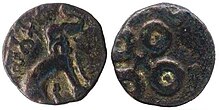
Back সাতকর্ণী Bengali/Bangla शातकर्णी प्रथम Hindi ശതകർണി I Malayalam पहिला सातकर्णी Marathi முதலாம் சதகர்ணி Tamil శాతకర్ణి Tegulu Сатакарні Ukrainian
| Satakarni | |
|---|---|
 | |
| Satavahana King | |
| Reign | 70 – 50 BCE |
| Predecessor | Kanha |
| Successor | Satakarni II Vedasri Satisiri |
| Spouse | Nayanika (Naganika) |
| Issue | Vedistri Satisisri |
| Dynasty | Satavahana |
| Father | Simuka |
| Religion | Hinduism[2] |
Satakarni (also called Sātakarnī I, Brahmi script: 𑀲𑀸𑀢𑀓𑀡𑀺, Sātakaṇi) was the third of the Satavahana kings, who ruled the Deccan region of India. His reign is generally dated to 70-60 BCE,[3] although some authors have claimed 187-177 BCE,[4] and most recently dated to 88-42 BCE.[5] It was thought there were "two Satakarnis" (Satakarni I and Satakarni II), however, Andrew Ollett argues that there is only one Satakarni, as the alleged first Satakarni is assigned ten years, and the second, fifty years by other scholars, but the only dated inscription of this king is Candankheda seal from his reign's year 30, around 60 BCE, and he ruled ca. 88-42 BCE.[6][7]
- ^ CNG Coins
- ^ Cite error: The named reference
Sudhakar_1974was invoked but never defined (see the help page). - ^ Carla M. Sinopoli (2001). "On the edge of empire: form and substance in the Satavahana dynasty". In Susan E. Alcock (ed.). Empires: Perspectives from Archaeology and History. Cambridge University Press. pp. 166–168. ISBN 9780521770200.
- ^ Rajesh Kumar Singh (2013). Ajanta Paintings: 86 Panels of Jatakas and Other Themes. Hari Sena. pp. 15–16. ISBN 9788192510750.
- ^ Ollet, Andrew, (2017). Language of the Snakes: Prakrit, Sanskrit, and the Language Order of Premodern India, University of California Press, Okland, Table 2, (Appendix A), p. 189.
- ^ Ollett, Andrew, (2017). Language of the Snakes: Prakrit, Sanskrit, and the Language Order of Premodern India, University of California Press, Okland, footnote 5, p. 190 and p. 195.
- ^ Falk, Harry, (2009). "Two Dated Satavahana Epigraphs", in Indo-Iranian Journal 52, pp. 197-200.